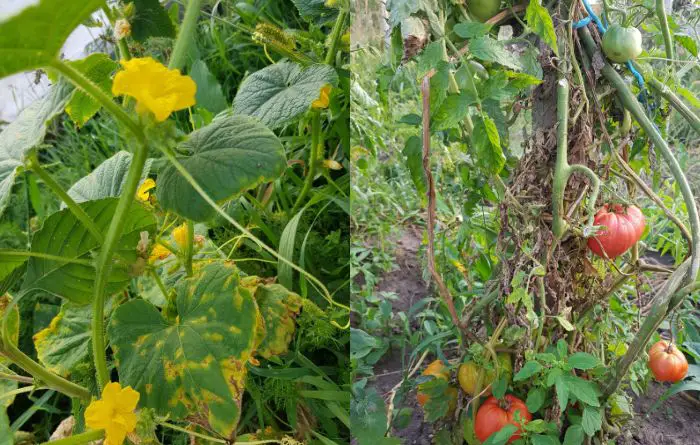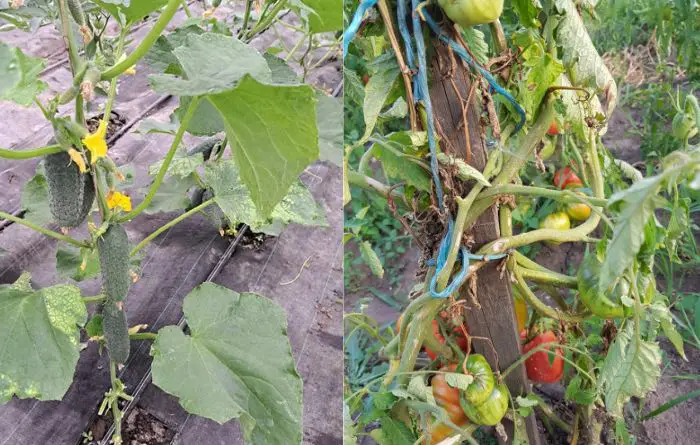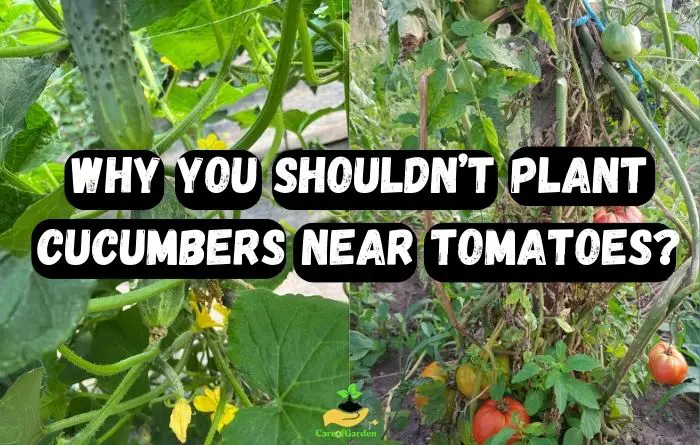Why You Shouldn’t Plant Cucumbers Near Tomatoes? [5 Reasons]
As a gardener, you may wonder why your cucumber and tomato plants just don’t get along in the garden. In this article, I will explain why you shouldn’t plant cucumbers near tomatoes, two popular garden vegetables that are often grown together but don’t make good companions.
Cucumbers should not be planted near tomatoes because they have different nutrient needs, attract the same pests, and can spread diseases to each other. Cucumbers are heavy feeders that require a lot of nitrogen, while tomatoes are heavy feeders that require a lot of phosphorus and potassium. When grown together, they can compete for nutrients and affect each other’s growth and yield. To ensure optimal growth and yield, it’s best to plant cucumbers and tomatoes at least 4-6 feet apart, or in separate garden beds.
Why Not to Plant Cucumbers Near Tomatoes
As an experienced gardener, I have learned that planting cucumbers near tomatoes is not a good idea. While it may seem like a convenient way to use your garden space effectively, it can actually cause problems for both plants.
Here are some reasons not to plant cucumbers near tomatoes:
1. Disease Susceptibility

Cucumbers and tomatoes are both susceptible to a variety of diseases, including blight and powdery mildew. When planted close together, they can easily spread these diseases to each other, leading to a weaker harvest or even complete crop failure. It’s best to keep them apart to prevent the spread of diseases.
Both are susceptible to the Mosaic Virus
One of the most common diseases that affect both cucumbers and tomatoes is mosaic virus. This virus can cause yellowing and stunted growth in plants, as well as a mosaic-like pattern on the leaves of both plants.
Once a cucumber plant is infected, there is no cure, and the virus can easily spread to tomato plants. Therefore, it is essential to prevent the spread of mosaic virus by avoiding planting cucumbers and tomatoes near each other.
Both are susceptible to Blight
Another disease that can affect both cucumbers and tomatoes is blight. There are two types of blight that can affect these plants: early blight and late blight.
Early blight is caused by a fungus that can survive in soil for several years, while late blight is caused by a water mold. Both types of blight can cause leaf spots, stem cankers, and fruit rot, leading to reduced yields.
To prevent blight, it is best to practice crop rotation and avoid planting cucumbers and tomatoes near each other.
Both are susceptible to Powdery mildew
Powdery mildew is another disease that can affect both cucumbers and tomatoes. It is caused by a fungus that forms a white powdery coating on the leaves, stems, and fruit of the plant. This can lead to reduced yields and even death of the plants.
To prevent powdery mildew, it is essential to ensure good air circulation around the plants and avoid planting cucumbers and tomatoes near each other.
2. Attract the Same Pests
In addition to diseases, there are several pests that can affect both cucumbers and tomatoes. Aphids and whiteflies are two common pests that can cause damage to the leaves and stems of both cucumber and tomato plants, leading to reduced yields.
Cucumber beetles are another pest that can cause damage to both cucumbers and tomatoes. These beetles can chew on the leaves and stems of the plants, leading to reduced yields and even death of the plant.
In conclusion, planting cucumbers and tomatoes together can lead to several disease and pest issues, including mosaic virus, blight, powdery mildew, aphids, whiteflies, and cucumber beetles.
To prevent these issues, it is best to avoid planting these plants near each other and practice good crop rotation and pest management techniques.
3. Soil and Nutrient Competition

Cucumbers and tomatoes both require a lot of nutrients to grow and produce fruit. When planted too close together, they will compete for these nutrients in the soil, which can result in stunted growth and smaller yields. By giving them their own space, you can ensure that they have access to the nutrients they need to thrive.
When planning your garden, it’s important to consider the needs of each plant and how they will interact with each other. One factor to keep in mind is soil and nutrient competition.
Plants require certain nutrients from the soil to grow and thrive, and if two plants are competing for the same nutrients, it can lead to stunted growth and a lower yield.
Cucumbers and tomatoes are both heavy feeders and require a lot of nutrients, especially nitrogen. When planted too close together, they will compete for the same nutrients in the soil.
This can result in weaker plants that are more susceptible to disease and pests. It’s best to plant these two crops at least a few feet apart to avoid this competition.
In addition to spacing, you can also help reduce soil and nutrient competition by using fertilizer and compost. Adding these materials to the soil can provide a boost of nutrients that will benefit all of your plants. However, it’s important to be careful not to over-fertilize, as this can lead to other problems such as nutrient burn.
Overall, it’s important to be mindful of soil and nutrient competition when planning your garden. By giving each plant the space and nutrients it needs, you can help ensure a healthy and productive harvest.
4. Sunlight and Space Considerations

As a gardener, I know that sunlight and space are crucial factors in determining the success of any plant. When it comes to growing cucumbers and tomatoes, these factors are even more important.
Cucumbers and tomatoes require different amounts of sunlight, with tomatoes needing more sunlight than cucumbers. Therefore, planting cucumbers near tomatoes can result in shading, which can hinder the growth of both plants.
For this reason, it is best to plant cucumbers in an area where they can receive full sun, away from any shade provided by tomato plants.
Another important consideration is proper spacing. Cucumbers and tomatoes are both vines and can quickly take up a lot of space in the garden.
Planting them too close together can lead to overcrowding, which can result in poor air circulation, increased risk of disease, and stunted growth. It is recommended to plant cucumbers and tomatoes at least two feet apart to ensure they have enough space to grow and thrive.
Proper spacing also allows for easier maintenance, such as pruning and harvesting. It is much easier to care for plants that have enough space between them, rather than trying to navigate through a tangled mess of vines.
5. Different Growing Habits
Cucumbers and tomatoes have different growing habits that can also cause problems when planted together. Cucumbers are known for their sprawling vines, which can quickly take over a garden bed.
Tomatoes, on the other hand, grow as tall plants that need support. When planted together, the cucumbers can easily smother the tomatoes, making it difficult for them to grow properly.
In conclusion, while it may be tempting to plant cucumbers and tomatoes together, it’s best to keep them apart. By doing so, you can prevent the spread of diseases, ensure that each plant has access to the nutrients it needs, and allow them to grow and produce fruit without competing with each other.
6. Negative Impact on Yield
When planning a vegetable garden, it’s important to consider which plants should be grown together. While it may seem like a good idea to save space and maximize yield, the truth is that planting cucumbers near tomatoes can have a negative impact on yield.
Cucumbers and tomatoes are both heavy feeders, meaning they require a lot of nutrients from the soil. When planted together, they will compete for these nutrients, resulting in smaller yields for both plants.
Additionally, cucumbers are known to attract pests such as cucumber beetles and squash bugs, which can also damage nearby tomato plants.
Furthermore, cucumbers and tomatoes have different growing habits. Cucumbers are vining plants that require a lot of space to grow, while tomatoes are bushy plants that don’t need as much room.
When planted together, the cucumbers can quickly take over and shade the tomatoes, reducing their access to sunlight and hindering their growth.
To maximize yield and promote healthy plant growth, it’s best to plant cucumbers and tomatoes in separate areas of the garden. This will allow each plant to receive the nutrients and space it needs to grow to its full potential.
In conclusion, while it may seem convenient to plant cucumbers and tomatoes together, it’s not a good idea for maximizing yield. By planting them separately, you can ensure that each plant has the space and nutrients it needs to thrive.
Alternative Companion Plants for Cucumbers
When it comes to companion planting for cucumbers, there are many options that can help improve the health and yield of your crop.
Here are some alternative companion plants for cucumbers:
| Cucumber Companion Plants | Benefits |
|---|---|
| Marigolds | Deters pests and attracts pollinators |
| Dill and Parsley | Attracts beneficial insects and improves flavor of cucumbers. |
| Nasturtiums | Deters pests and attracts pollinators |
| Beans and Peas | Nitrogen-fixing abilities improve soil health and increase harvest yields |
| Lettuce | Provides shade and moisture retention |
| Radish | Deters cucumber beetles and improves soil health |
| Corn | Provides shade and structural support |
| Nasturtiums | Deters pests and attracts pollinators |
| Celery | Improves soil health and attracts beneficial insects |
| Borage | Improves flavor of cucumbers and attracts beneficial insects |
| Sunflowers | Provides shade and structural support |
Marigolds
Marigolds are a great companion plant for cucumbers because they help repel pests such as nematodes and cucumber beetles. They also attract beneficial insects such as ladybugs and lacewings, which can help control aphids and other pests.
Dill and Parsley
Dill and parsley are both great companion plants for cucumbers because they attract beneficial insects such as hoverflies and wasps, which can help control pests such as aphids and caterpillars. They also help improve the flavor of cucumbers.
Nasturtiums
Nasturtiums are another great companion plant for cucumbers because they help repel pests such as aphids and cucumber beetles. They also attract beneficial insects such as hoverflies and ladybugs.
Peas and Beans
Peas and beans are great companion plants for cucumbers because they help improve the soil by fixing nitrogen. They also provide shade for the cucumbers, which can help prevent sunscald.
Carrots
Carrots are a good companion plant for cucumbers because they help improve the soil by breaking up hard soil and adding organic matter. They also provide a good ground cover, which can help prevent weeds.
Basil
Basil is a good companion plant for cucumbers because it helps repel pests such as thrips and flies. It also improves the flavor of cucumbers and can be used in many recipes.
Overall, there are many alternative companion plants for cucumbers that can help improve the health and yield of your crop. By planting a variety of companion plants, you can create a healthy and diverse garden ecosystem that will benefit all of your plants.
Alternative Companion Plants for Tomatoes
When it comes to companion planting, there are several plants that can be grown alongside tomatoes to boost their growth and health. Here are some of the best alternative companion plants for tomatoes:
Marigolds and Nasturtiums
Marigolds and nasturtiums are both great companion plants for tomatoes. They help to repel pests and attract beneficial insects like ladybugs and lacewings. Marigolds also release a chemical that can help to suppress nematodes in the soil.
Corn
Corn is another great companion plant for tomatoes. It provides shade and helps to retain moisture in the soil. It also attracts beneficial insects like ladybugs and lacewings.
Eggplant and Peppers
Eggplant and peppers are members of the nightshade family, just like tomatoes. They have similar nutrient requirements and can be grown together without competing for resources. Plus, they help to repel pests like aphids and spider mites.
Fennel
Fennel is a great companion plant for tomatoes because it attracts beneficial insects like ladybugs and lacewings. It also has a deep root system that helps to break up compacted soil.
Herbs
Many herbs are great companion plants for tomatoes. Basil and parsley, for example, help to repel pests like tomato hornworms and whiteflies. Rosemary and thyme also have insect-repelling properties.
Carrots
Carrots are a great companion plant for tomatoes because they have a deep root system that helps to break up compacted soil. They also attract beneficial insects like parasitic wasps, which help to control pests like aphids and caterpillars.
Lettuce
Lettuce is a great companion plant for tomatoes because it provides shade and helps to retain moisture in the soil. It also attracts beneficial insects like ladybugs and lacewings. Plus, you can harvest the lettuce leaves before the tomato plants get too big.
Overall, there are many alternative companion plants for tomatoes that can help to boost their growth and health. By planting a variety of plants together, you can create a diverse and healthy garden ecosystem.
Can you plant cucumbers and tomatoes together in the winter?
It’s unlikely that you can plant cucumbers and tomatoes together in the winter, as both plants are warm-season crops that require warm soil temperatures and ample sunlight to grow and produce fruit. In most regions, winter temperatures are too cold for these plants to thrive.
However, if you live in a region with mild winters, you may be able to plant cucumbers and tomatoes together in a greenhouse or other protected environment that provides the warmth and sunlight they need.
In this case, it’s important to choose varieties that are well-suited to greenhouse growing conditions and to provide consistent moisture and fertilization.
| Cucumber varieties that are well-suited to greenhouse growing conditions: |
|---|
| 1. Telegraph Improved |
| 2. Miniature White |
| 3. Socrates |
| 4. Marketmore 76 |
| 5. Sweet Success |
| 6. Tasty Jade |
Keep in mind that even in a greenhouse, cucumbers and tomatoes may have different growing requirements and may compete for space and nutrients.
It’s important to research the specific varieties you plan to grow and to provide optimal growing conditions for each plant to ensure a successful harvest.
Can you grow cucumbers and tomatoes together in a greenhouse?
Yes, you can grow cucumbers and tomatoes together in a greenhouse. In fact, growing these two plants together can be beneficial as they have similar growing requirements and can help to maximize space and yield in a greenhouse environment.
When growing cucumbers and tomatoes together in a greenhouse, it’s important to choose varieties that are well-suited to greenhouse growing conditions. Look for varieties that are disease-resistant and have a compact growth habit to maximize space.
It’s also important to provide optimal growing conditions for both plants, including consistent moisture, proper fertilization, and adequate light and temperature.
Cucumbers and tomatoes both require warm soil temperatures and ample sunlight to grow and produce fruit, so make sure to provide enough light and warmth in your greenhouse.
To prevent issues such as pests and diseases, it’s important to maintain good air circulation and to monitor your plants regularly for signs of trouble.
Consider using natural pest control methods such as companion planting or introducing beneficial insects to help keep pests under control.
Overall, growing cucumbers and tomatoes together in a greenhouse can be a great way to maximize space and yield while providing fresh, homegrown produce year-round.
Conclusion
In conclusion, planting cucumbers near tomatoes is not recommended due to several reasons:
- Firstly, cucumbers are sensitive to diseases that can be easily spread by tomato plants, which can lead to poor growth and yield.
- Secondly, both cucumbers and tomatoes are vines that require ample space and good air circulation to thrive, and planting them too close together can lead to poor growth and disease.
- Thirdly, cucumber plants have extensive root systems and require ample amounts of water and nutrients, which can deplete the resources available for the tomato plant to thrive.
- Fourthly, both cucumbers and tomatoes are invasive vines that can quickly take over your garden if not kept in check.
- Finally, diseases such as Cucumber Mosaic Virus and Phytophthora Blight can affect both cucumbers and tomatoes and can quickly spread from one species to the other, with no cure available.
- Therefore, it is best to plant cucumbers and tomatoes separately, or at least with ample space between them.
Frequently Asked Questions
Companion planting is a great way to improve the health and productivity of your garden. Some good companion plants for cucumbers and tomatoes include basil, marigolds, and radishes. Basil can help repel pests that are attracted to tomatoes and cucumbers, while marigolds can help deter nematodes. Radishes can also help repel pests and break up the soil, making it easier for the roots of your plants to grow.
lanting cucumbers and tomatoes too close together can lead to a number of problems. For one, both plants are prone to diseases such as blight and mildew, which can spread more easily when they are growing in close proximity. Additionally, cucumbers and tomatoes have different nutrient needs, and planting them too close together can result in competition for resources.
Planting cucumbers and tomatoes together can affect their growth and yield in a number of ways. As mentioned earlier, both plants have different nutrient needs, and planting them too close together can result in competition for resources. Additionally, cucumbers and tomatoes have different growth habits, with cucumbers growing up and tomatoes growing out. This can result in overcrowding and shading, which can negatively impact the growth and yield of both plants.
Yes, there are some vegetables that should not be planted near cucumbers and tomatoes. These include members of the nightshade family, such as peppers and eggplants, as well as potatoes. These plants are all prone to similar diseases and pests, and planting them together can increase the risk of problems.
If you can’t plant cucumbers near tomatoes, there are still plenty of other options for your garden. Some good companion plants for cucumbers include beans, corn, and peas. These plants can help fix nitrogen in the soil, which can benefit your cucumbers. You can also consider growing your cucumbers vertically, using a trellis or other support structure.
The best time to plant cucumbers and tomatoes together is in the spring, after the danger of frost has passed. Make sure to choose a sunny location with well-draining soil, and space your plants out according to their specific needs. It’s also a good idea to rotate your crops each year, to help prevent the buildup of pests and diseases in the soil.




